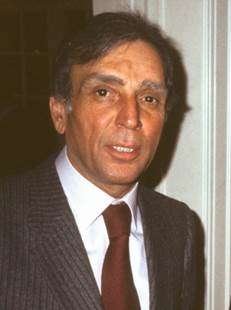S. Ichtiaque Rasool
(academic, writer, researcher) | |
|---|---|
 | |
| Born | 1930 Lucknow, India |
| Died | April 20, 2016 (Age 85) Bethesda, Maryland, USA |
| Nationality | USA |
| Alma mater | University of Paris. |
| Interests | • “climate change” • environment • global cooling |
Wrote a working paper on global warming for the 1989 Bilderberg, proposing a large program of training dedicated cadre "motivated and placed in various strategic positions in industry, government and academia" and making it "a permanent and prominent part of our scientific, political and foreign policy agendas." | |
Dr. S. Ichtiaque Rasool was Chief Scientist for Global Change at NASA.[1] Known for his conclusion that a global cooling was taking place in the 1970s, he had changed opinion, and wrote a working paper on Environmental Constraints for the 1989 Bilderberg[2], arguing that a human-caused global warming was taking place that required large global economic and political changes. The new focus came just as the Cold War was ending and a new "enemy" was needed.
Contents
Education and early career
Rasool was born in Lucknow, India. He got his doctorate in atmospheric sciences in 1956 from the University of Paris.
He moved to the U.S. in 1961 at the invitation of Robert Jastrow of the Goddard Institute for Space Studies (GISS) and began a long career with the National Aeronautics and Space Administration (NASA).[3]
Career
In 1968 he spent a sabbatical year in Paris, during which he gave lectures and helped form a planetology group at the Paris Observatory. He wrote one of the early papers on the runaway greenhouse effect on Venus.[4]
He became a U.S. citizen in 1970, and in 1971 he moved to NASA Headquarters as the deputy director for Planetary Programs. Later, Rasool worked as Noel Hinners' deputy in the Office of Space Science before moving to work on NASA's earth science programs.[3]
In 1971 he and Stephen Schneider concluded in a paper that the earth might cool by 3 to 5 degrees Celsius (5 to 9 degrees Fahrenheit) caused by carbon dioxide combined with chlorofluorocarbons.[5] Rasool wrote that this could be "sufficient to trigger an ice age."[6]
Rasool was a co-founder of the International Satellite Land Surface Climatology Project (chairman from 1981 to 1992), and was one of the founders of the International Geosphere-Biosphere Programme (IGBP). He was instrumental in establishing the NASA Pathfinder program for global data sets and became director of the IGBP Data and Information System in 1990.[7]
Bilderberg 1989

Rasool wrote a working paper on Environmental Constraints for the 1989 Bilderberg[2], arguing that a human-caused global warming was taking place that required large global changes. The new focus came just as the Cold War was ending and a new "enemy" was needed.
Even though he pointed out that his conclusions were based on "a background of uncertainty" he still mapped out a large-scale program to reinforce the concept of man-made global warming.[2] Since he was chosen to set the premises for the 1989 debate, this was likely wanted by the organizers of the Conference.
Rasool hedged that further study was needed: "There are currently available data records from the last 10 to 20 years that can be analyzed to determine whether there is a clear and unambiguous greenhouse warming 'signal' that will stand out above the current 'noise' of climate change."[2] He also wanted expanded predictive modelling: "Also within the reach of today's technology is our ability to improve our predictive models[2]," a method that is frequently abused to reach preset conclusion.
Rasool suggested that "the United States must take the lead in this effort not by doing it alone but by making the issue of global change a permanent and prominent part of our scientific, political and foreign policy agendas. We can lead by our example. It is not necessary to wait 10 or 20 years to begin to make adjustments....[2]
Rasool wanted to create a dedicated cadre to further the climate change agenda:
- Each country must seek their brightest individuals from science, academia, industry and government and have them turn their attention to the solution of these problems.[2]
- The right people must be identified, motivated and placed in various strategic positions in industry, government and academia.[2]
- Environmental issues must become an integral part of national policies, economic developments and international affairs.[2]
- The educational system must be adjusted to focus on strong interdisciplinary topics that will produce a new generation of scientists and engineers that will be the infrastructure upon which future advances will be made.[2]
Klaus Töpfer who at Bilderberg 1989 wrote the introductory remarks for the discussion after Rasool's paper, later became involved in behind-the-scenes negotiations of the 1997 Kyoto Protocol, and then executive director of the United Nations Environment Programme (UNEP) in 1998.
Event Participated in
| Event | Start | End | Location(s) | Description |
|---|---|---|---|---|
| Bilderberg/1989 | 12 May 1989 | 14 May 1989 | Spain La Toja Island Galicia | 37th Bilderberg meeting, 110 guests |
References
- ↑ https://www.tributearchive.com/obituaries/2462941/Ichtiaque-Rasool
- ↑ a b c d e f g h i j File:Bilderberg-Conference-Report-1989.pdf
- ↑ a b https://dps.aas.org/news/s-ichtiaque-rasool-1930-2016/
- ↑ https://doi.org/10.1038%2F2261037a0
- ↑ https://willsarvis.medium.com/beware-of-climate-predictions-55cf9e6fc3df
- ↑ https://science.sciencemag.org/content/173/3992/138.abstract
- ↑ https://prd-wret.s3.us-west-2.amazonaws.com/assets/palladium/production/s3fs-public/atoms/files/2002_Pecora_Signed-Rasool.pdf